Edward B. Graveur – Magic and Racy Literature
Not every story of a magician in Australia concerns a professional with a long career. Edward B. Graveur, as a young man, flirted around the edges of magic and theatrical management before adopting a long-term career as a bookseller, and his non-magic scandals are more interesting than his theatre. However, we also obtain some further clues as to where an up-and-coming magical hobbyist might have obtained their information in pre-1900 Sydney.
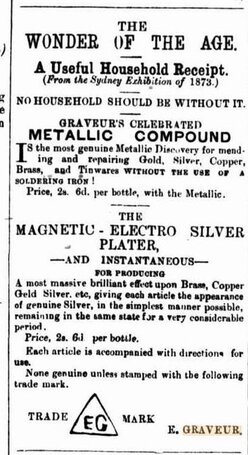
Little can be discovered of Graveur’s life history other than a likely birthdate of 1853 or 1854. He went through a number of names and spellings, and may been actually been “Aaron Knowles” or “Aaron Gravene”. He first comes to notice in November 1873 (1) in a newspaper advertisement at Bega, promoting “Graveur’s Celebrated Metallic Compound” for repairing gold, silver, copper, brass and tin without the use of a soldering iron; and also the “Magnetic Electro Silver Plater” for coating metals in a silvered sheen. These products are linked to the Metropolitan Intercolonial Exhibition held in Sydney during April 1873, though no particular reference can be found in the exhibition catalogue. Prior to July 1873 he is recorded (unclaimed mail) as living at Margaret Street in Sydney, and he seems to have moved to East Maitland for a time before 1874.
In April 1874, Graveur’s name appears as one of the cast of the “Lyceum Troupe” performing at the Hunter’s Hill Council Chambers (Sydney) with ‘many novelties’. The same troupe seems to have performed at Windsor School of Arts in January.
Also named in the troupe is “Barker”, who at first glance would have been thought to be Gordon A. Barker, a young magician who would be seen regularly performing with amateur or semi-professional concert parties, and with a focus on spirit-expose feats. However criminal proceedings in 1878 name him as a 24-year old Alexander Barker. Although the linkage is not conclusive, there is a reasonable certainty that Alexander went on to perform under the name “Alec Barker” or “Gordon A. Barker” for many years, and was the same performer who was involved in the anti-spiritualist exposes in our essay on “Spooks”.
Notably, the manager of the troupe is shown as E. Graveyre (or in another advertisement, Graveire), indicating that Edward was ambitious to try his hand at theatrical production. These musical and dramatic troupes formed and dissolved rapidly, and nothing more is heard of the Lyceum Troupe, but on January 26, 1875, a concert was held at Goulburn Mechanics’ Institute, “a lengthy and good programme put together by local amateurs”, in support of those who had suffered during fires at Windsor. (2) “Mr. Harvey then came forward, introducing Mr. Graveur, the performer of the great Davenport secret, and called on two gentlemen from the audience to tie Mr. Graveur with ropes. This was done, the performer being securely fastened with a strong rope from the shoulders downwards. Mr. Graveur was then put into a canvas sack, the mouth of which was tied over his head with a stout cord. A lapse of about one minute took place, when the bag was loosed, and the performer appeared with the rope coiled loosely in his hand and not a vestige of it about his body.”
The Illawarra Mercury of May 28 advertised The Great American Combination Troupe of Startling Illusions and Wonderful Novelties, headed by the ‘Young Australian Wizard, Conjuror, and Spiritualism Exposer, Mr. Edwd. B. Graveur …’ to appear in Woonona on May 29 and 31, and the Temperance Hall, Wollongong on June 1 and 2. The troupe, ‘having gained a popular reputation in different parts of the country visited by them’ was said by The News (Shoalhaven) of June 9 to be ‘spoken of very highly by several of our contemporaries.’ Advertising added further to the troupe’s name as the “Hibernica-American Troupe”, and E.B. Graveur was the ‘proprietor’.
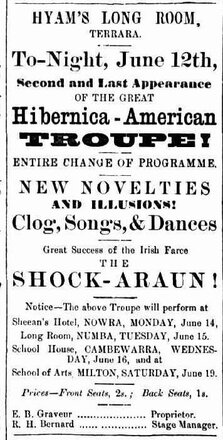
For all the fancy press, however, a report of the show in July at Moruya (3) was scathing – “The Graveur Company - the performance of the above Co., on Monday night last, was considered to be as great a sell as has even been perpetrated at Moruya. There was one novel feature in the course of the evening, viz., a black ghost! Many of the audience appeared to be ashamed at being present, and we are glad to perceive that the public taste of Moruya was above the delectable trash (we might say disgusting buffoonery) exhibited before them on the occasion we are noticing.” No more is heard of this particular troupe.
Graveur seems to have retreated to his former talent of creating chemical products, widely advertising a ‘non-explosive powder which, put into a kerosene lamp, obviates all danger of bursting though it be overturned .. it gives no trouble, causes no direct, and the light can be extinguished at a breath.’ The inventor was living at 42 King Street Sydney.
He is next seen with Mr. Barker again in a weekly concert at St. Joseph’s Hall, Balmain. (4) “Mr. Barker, in his drawing-room of magic delights, astonishes all with his wonderful manipulation and clever way of performing. Mr. Barker, in conjunction with Mr. E.B. Graveur, on Monday night, performed the Davenport Brother’s spiritualistic rope-tying on chairs in a very creditable manner; the performers after being securely tied, then freed themselves in two minutes. “
Again, at the Queen’s Theatre in a semi-professional Benefit night on September 5, 1876, the bill was headed by ‘Mr. A. Barker’ with Magic and Mystery, later joining with Mr. Graveur for Rope Tying a la Davenport Brothers.
Salesman in Trouble
Graveur seems to have involved himself in 1878 with a newly arrived firm named the American Novelty Company. Located at 66 Market Street Sydney, Eastern Arcade Melbourne, and Rundle Street Adelaide, they were purveyors of ‘American Novelties, oddities, Yankee Notions and Patent articles of every description’ which encompassed everything from glues to stationery, needles and knives. They also sold agencies to canvassers and salesmen for “a few shillings capital”, promising large commissions to be made by ‘active men’.
In January 1878, Graveur placed some lengthy advertising in the Singleton Argus promoting a free entertainment/experiment in the streets of Singleton, which appears to be an exhibition of his non-explosive lamp powder; again he claimed to have sold this at the Sydney Exhibition to the tune of 100,000 packets. The Argus came off second best, advertising on February 23 to find Mr. Graveur’s address, or that of the main agent for the American Novelty Company, which suggests that he had not paid his bill.
May 1878 brought further trouble for Graveur. He was charged on a warrant with having stolen sixty packets of ‘Hill’s Magic Vermin-killer’, valued at £6, from an Arthur Cubitt. Alongside him in the charge was his magical colleague, Alexander Barker. Through these proceedings we learn that Graveur was also known by the name ‘Knowles’, was 25 years of age, 5 feet 7 inches tall, dark hair, reddish whiskers and Jewish appearance, dressed in a black coat and vest with a tall black hat. Barker, 23 years, was mentioned as a conjuror whose father was a news agent in Sussex Street, and both were hawking goods for the American Novelty Company.
In an indictment on journalistic standards, Graveur’s name was reported as “Ann Carver” rather than “Aaron Graveur” in the Evening News of May 30. The jury deliberated for two hours, and believed they would not be able to agree on Barker’s guilt, so he was discharged. Graveur, however, was found guilty and sentenced to six month’s hard labour at Bathurst Gaol. Again raising a variant of his name, the Police Gazette sentencing record shows his name as Aaron Gravene alias Knowles, and it is likely that this is the true name of our character.
Books and Obscenity Charge
Once again free, ‘Edward B. Graveur’ as he was afterwards known, became an agent for the Sydney Courier daily penny paper in 1879. By 1880 he was advertising regularly as ‘E. Graveur, Bookseller’, starting at 356 Harris Street Ultimo, then under the name of the “American, English and Australian Book Depot” at 196 George Street and, over the years to come, moving to very many different addresses around Sydney.
This was to be his lifelong career, and he was selling some general items such as Christmas and New Year cards, or pictorial views of the city and countryside, scrapping books, song books etc. Another of his publications was "The Life and Adventures of the Kelly Outlaws". 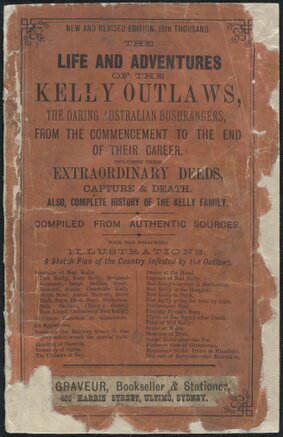

Of particular interest is the “Magic Card Packet” he sold in 1882, containing 14 new tricks full of fun, or ‘interesting, simple and magical card tricks’ – post free, 2s. 4d. Later that year he sold a Novelty Packet of 15 new and wonderful tricks. Graveur was one of a number of businesses selling small magical items to the general public, and a separate essay will address those.
From the start, though, he was also promoting some books of “sensational stories” and others which had an implied scandalous or sexually titillating theme, sometimes using the advertising header “The Spiciest Book Ever Published” –
The Day’s Doings
After Dark, being a secret book for ladies
Life of Moll Flanders or Gay Life in London
Awful Disclosures of Maria Monk and the Mysteries of a Convent
The Male Generative Organs, Marriage Guide
The Diseases of Women, with coloured plates
The Sly Grog Shop
Melbourne Love Tale
The Secrets of Nature
Ovid’s Art of Love
The Day’s Doings
After Dark, being a secret book for ladies
Life of Moll Flanders or Gay Life in London
Awful Disclosures of Maria Monk and the Mysteries of a Convent
The Male Generative Organs, Marriage Guide
The Diseases of Women, with coloured plates
The Sly Grog Shop
Melbourne Love Tale
The Secrets of Nature
Ovid’s Art of Love
For all the suggestive titles, these works were little more than the penny dreadfuls or salacious fiction of the day; mildly exciting tales of low life and crime. “Sydney Day and Night” can be viewed at http://digital.sl.nsw.gov.au/delivery/DeliveryManagerServlet?embedded=true&toolbar=false&dps_pid=IE15622999&_ga=2.60013357.1472496968.1616831371-1592475657.1616831371
and it contains little to bring a blush to the cheeks of even a nineteenth century citizen of Sydney.
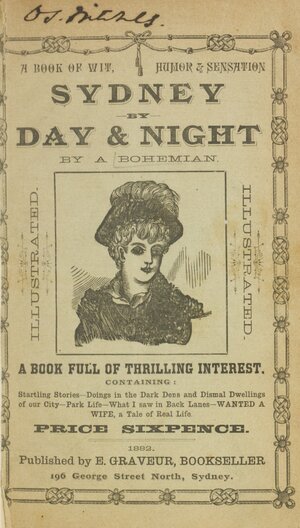
In some cases, there were books of medical and biological information which might serve as some form of sexual education, unobtainable elsewhere. It would seem that such books were frowned upon because they may have provided some awareness of either contraception, abortion, or impotence cures. Either way, Graveur was a regular feature in the “back pages” advertisements in journals such as the Town and Country Journal, and seemed happy to promote himself as a purveyor of racy materials. It would prove to be his undoing.
In October 1884, Graveur, at the address of 279 Pitt Street, was charged with having sold an obscene publication, titled “The Elements of Social Science; or Physical, Sexual and Natural Religion” which the prosecuting police officer, Inspector Anderson, described as the ‘most obscene that had come under his notice during his long connection with the police force…’ Police found 987 books of an allegedly obscene nature including ‘The Fruits of Philosophy’, ‘Paris by Gaslight’, ‘The Mysteries of Nature’ and ‘Dark Deeds Unravelled.’ The prosecution claimed that the works incited women to disregard the general definition of virtue and chastity, and that prostitution was held to be a benefit to society. The bench considered the case proved and ordered the books destroyed, and Graveur was fined £20 in default of which was a three months’ gaol term.
This court action brought a considerable backlash against police censorship, the Conference of Freethinkers bringing a resolution in protest, and press articles decrying the heavy-handed approach by officers who had no qualification or right to determine what was morally offensive:
[North Australian, November 14, 1884]
“Nobody means to be told what obscenity means. Mr. Graveur, bookseller of Sydney NSW, was charged with selling books that could be classed under the head ‘Obscene’ … when we inform the public that since the judgment, one may see any day a crowd around the bookseller’s window, we may be certain that he will not lose much over the matter … when we find books which are not obscene, but written by pure-minded scientific men and women, whose characters are above reproach, condemned equally with the others, it is a question to be asked; who are to be the censors? … The two books grouped as obscene are “Elements of Social Science” and “The Fruits of Philosophy”. However wrong the conclusions of the authors, it is a fact any pure-minded man may settle for himself, that in both there is nothing but an honest attempt to persuade people to follow the order of nature, and not to have more children than they can afford to keep. There is not a line nor a word of impurity in either of the two books mentioned. If there were others in which obscenity was undeniably shown, Mr. Graveur … gets just what he deserves. But to group harmless plain speaking with filth … is to introduce a ridiculously incompetent tribunal, and to hand over the liberty of the people to an interested and grossly ignorant tyranny.”
“Nobody means to be told what obscenity means. Mr. Graveur, bookseller of Sydney NSW, was charged with selling books that could be classed under the head ‘Obscene’ … when we inform the public that since the judgment, one may see any day a crowd around the bookseller’s window, we may be certain that he will not lose much over the matter … when we find books which are not obscene, but written by pure-minded scientific men and women, whose characters are above reproach, condemned equally with the others, it is a question to be asked; who are to be the censors? … The two books grouped as obscene are “Elements of Social Science” and “The Fruits of Philosophy”. However wrong the conclusions of the authors, it is a fact any pure-minded man may settle for himself, that in both there is nothing but an honest attempt to persuade people to follow the order of nature, and not to have more children than they can afford to keep. There is not a line nor a word of impurity in either of the two books mentioned. If there were others in which obscenity was undeniably shown, Mr. Graveur … gets just what he deserves. But to group harmless plain speaking with filth … is to introduce a ridiculously incompetent tribunal, and to hand over the liberty of the people to an interested and grossly ignorant tyranny.”
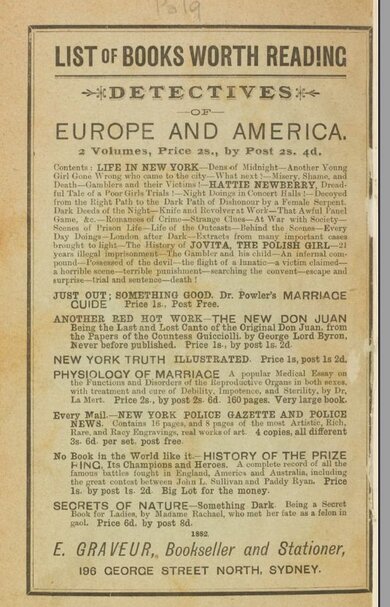
In the longer term, perhaps, Graveur’s business did not suffer immensely; but in the short term he and his family seem to have been severely affected by the £20 fine. At the Haymarket Academy on November 26, 1884, an entertainment was given by the Vaudeville Minstrels, in aid of Mrs. E.Graveur and her five children, “who are in great distress.” By March of 1885 (5) Graveur was proceeded against in the Newtown Police Court for having neglected to provide for his wife and family. The rooms of his house at Sydenham Road, Newtown, were “actually reeking with excrement … the children were quite naked .. this is the second time they have been found in this condition, and quite recently the Mayor of Marrickville had the children supplied with food and clothing, but to little purpose … the man Graveur cleared out, but was arrested yesterday.” This desertion and neglect scandal pursued Graveur right through to June 1887, when he was sent to gaol until he complied with an order of the court for payment of £10 10s. towards the support of his wife.
We will not follow Mr. Graveur’s later life in detail, but he continued in much the same trade for many more years, advertising constantly, with possibly a milder range of publications including general photographic albums and music portfolios. By 1890 he had resumed selling some of his spicier titles, and his multiple addresses now included an outlet in Queen Street, Brisbane. His business is last sighted in September 1897 selling ”72 lively photos from life … striking positions so realistic that it is with difficulty you pass one to view the next.”
In 1905 “E. Graveur’s Assembly” was announced at the Oddfellows Hall in Redfern, for every Saturday, but there is nothing known about these gatherings.
In 1905 “E. Graveur’s Assembly” was announced at the Oddfellows Hall in Redfern, for every Saturday, but there is nothing known about these gatherings.
It is possible that Edward Graveur died on July 2, 1907, if the unmarked grave at Rookwood General Cemetery is the same person.
REFERENCES
(1) Bega Gazette and Eden District or Southern Coast Advertiser, November 27, 1873.
(2) Goulburn Herald and Chronicle, January 27, 1875
(3) The News, Shoalhaven, July 7, 1875.
(4) Evening News, August 31, 1876.
(5) Evening News, March 25, 1885